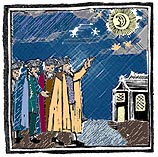The regular appearance
of moon is regarded in Jewish tradition as one of those benefits for
which praise and thanksgiving should be given to God The blessing of
the new moon, called qiddush levanah or birkat ha-levanah,
originated in the Second Temple period, but there are scholars who claim
it may be of much older origin. The rite takes the moon as a symbol
of the renewal in nature as well as of the renewal and redemption of
Israel, whose glory will be restored during messianic times.
 This
blessing is recited outdoors, shortly after Rosh Hodesh, at the reappearance
of the lunar crescent - anytime between the fourth of the month (when
the moon is clearly visible) and the fourteenth (when it is full). In
the month of Tishrei, the blessing is usually recited on the evening
after Yom Kippur (the eleventh of Tishrei); in Av, on the evening after
Tisha B'av (on the tenth of Av). Kiddush Levanah is not recited on the
Sabbath and holiday eves, mainly because of the prohibition of carrying
prayerbooks outside the synagogue in the public domain.
This
blessing is recited outdoors, shortly after Rosh Hodesh, at the reappearance
of the lunar crescent - anytime between the fourth of the month (when
the moon is clearly visible) and the fourteenth (when it is full). In
the month of Tishrei, the blessing is usually recited on the evening
after Yom Kippur (the eleventh of Tishrei); in Av, on the evening after
Tisha B'av (on the tenth of Av). Kiddush Levanah is not recited on the
Sabbath and holiday eves, mainly because of the prohibition of carrying
prayerbooks outside the synagogue in the public domain.
The basic text of
the blessing is given in the Talmud,[1]
but many additions were subsequently added, differing in the Ashkenazi
and Sephardi traditions.
Blessed
are You, Lord our God, King of the universe, who created the heavens
by your command, and all their host by Your mere word. You have subjected
them to fixed laws and time, so that they might not deviate from their
set function. They are glad and happy to do the will of their Creator,
the true Author, whose achievement is truth. He ordered the moon to
renew itself as a glorious crown over those He sustained from birth,
who likewise will be regenerated in the future, and will worship their
Creator for His glorious majesty. Blessed are You, O Lord, who renews
the month.
Blessed by your omnipotent Creator, O moon!
Even
as one cannot touch the moon, so may my foes be unable to harm me. May
terror and dread fall on them; may they be as motionless as a stone
under the sweep of your arm. Long live David, king of Israel.

Letters
appearing in any book in large print are referred to in Hebrew as (otiot
shel qiddush levanah), letters for sanctifying the new moon. This
is because the blessing for the sanctification of the moon is recited
outdoors by moonlight, and the print in the print at this place in the
prayerbook is therefore always large.

The phrase "Long
live David King of Israel," repeated three times, voices Israel's
continuous hope for redemption by the Messiah, a descendant of David
whose kingdom will be "established forever as the moon."[2]
The worshippers extend the greeting Shalom Aleikhem (peace be
to you) to those standing around, and they respond in kind Aleikhem
Shalom (to you be peace).

Another part of
the text alludes to an Talmudic legend according to which the sun and
moon are equal in luminosity at the time of creation; God then diminishes
the moon's radiance, but regrets having done so. The midrash predicts
that in the Messianic Age, the moon will regain the radiance and luminosity
it enjoyed at the beginning of time. "May the light of the moon
be as radiant the light of the sun and the light of the seven days of
creation, as it was before it was diminished, as it says [Gen. 1] "the
two great luminaries"....[3]
(For a contemporary reading of this midrash see The Moon: A Feminine
Affair).
|
[1]
Sanhedrin 42a and Soferim 2:1 [back]
[2] Psalms 89:38 [back]
[3] Sanhedrin 42; Hullin 60b [back] |